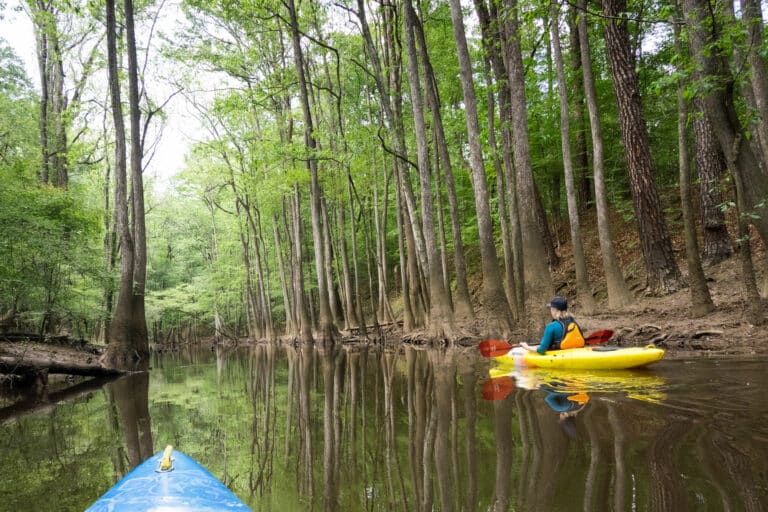1. GET DIRTY FOR CLEAN WATER
June 18 is River Action Day, when concerned citizens from across the country will join American Rivers in storming the halls of congress to demand stronger legislation for healthier rivers. If you prefer streambanks to marble halls, you can join the 100,000 volunteers organizing river cleanups. Last year the effort removed 600 tons of trash—including washing machines, an exercise bike, and a hot tub—and cleaned 7,453 miles of rivers. More info: www.americanrivers.org.
2. CANDIDATES STUMPED ON MOUNTAINTOP REMOVAL
Over 470 mountains in the region have been blown up as a cheap method of extracting coal, while the resulting waste has buried streams with over 100 million pounds of toxic heavy metals. But the Democratic frontrunners still don’t get it. When asked about mountaintop removal on West Virginia public radio, Clinton offered this gem of a solution: “Maybe there is a way to recover those mountaintops once they have been stripped of the coal. You know, I think we’ve got to look at this from a practical perspective.” Meanwhile, Obama is trying to greenwash the coal industry by perpetuating the “clean coal” myth, despite the legacy of destruction wreaked by strip mining in his home state of Illinois. Apparently, money still talks louder than the sound of dynamite blasting off another Appalachian mountaintop.
3. RACCOONS GONE WILD
The Appalachian Trail Conservancy has partnered with the Smithsonian Institute to install and maintain 50 motion-sensor infrared trail cameras along a 575-mile stretch of the Appalachian Trail. The Smithsonian is using the cameras to conduct a wildlife survey to help determine the number of large mammals living in a certain area. Scientists hope the images and data collected will help them understand the effects of human encroachment on an animal’s natural habitat. A similar project performed last year on the A.T. showed an abundance of predators like coyote, bobcat, and black bear.
4. TWO HEADS BETTER THAN ONE?
Jan Davis received a big surprise from a newly hatched bearded dragon: the reptile came out with two heads. Davis and her husband breed reptiles in Kernsville, North Carolina. Although the malformation is very rare, it is not unheard of in the exotic species, which can grow up to 20 inches. According to an NBC news report, the couple does not plan to sell the reptile, but they are confused about which head to feed.
5. RIVER BLUES
The Catawba-Wateree River in North Carolina and South Carolina was named the most endangered river of 2008 in a report released last month by American Rivers. The report cites explosive population growth in the Carolina piedmont and poor water management as the primary reasons for Catwaba-Wateree’s most endangered status. The 300-mile river provides drinking water for 1.3 million people in Charlotte and provides electricity for at least one million people there. The Catawba-Wateree is also at the center of water wars between North and South Carolina over the right for Charlotte suburbs to pump even more water out of the river. The conflict has reached the Supreme Court.
6. STATE SAYS DOMINION’S “CARBON CAPTURE” BOGUS
When Dominion Energy applied to build a new 585-megawatt coal-fired power plant in Wise County last year, the energy giant promised it was going to be “carbon capture compatible” and “a model of modern environmental controls.” But the State Corporation Commission (SCC) has deemed it a conventional coal facility with no plan to capture its estimated 5.4 million tons of harmful annual emissions, including a disproportionate amount of toxic mercury. Despite the false claims of carbon capture, the SCC approved the facility anyway, ignoring massive public opposition. Last month, Southern Appalachian Mountain Stewards delivered to Richmond a mile-long petition of 42,000 signatures of local citizens opposing the power plant. And Southern Environmental Law Center has filed a petition challenging the plant’s mercury emissions.
7. GREEN COLLAR
Last month, a partnership between the United Steelworkers, the Sierra Club, and the Natural Resources Defense Council launched a major campaign to create an abundance of new jobs in green energy. Green Jobs for America will target 12 states, including Virginia, Tennessee, Pennsylvania, Ohio, and Florida, to reduce the use of fossil fuels and generate a total of 820,000 alternative energy jobs across the country. The 12 target states stand to gain nearly 170,000 new jobs in wind turbine manufacturing and almost 93,000 new jobs making solar power equipment.
8. DUKE’S NEW NUKES
Duke Energy has proposed two nuclear power plants in Gaffney, S.C., roughly midway between Charlotte, N.C., and Spartanburg, S.C. The nuclear plants will cost at least $18 billion, consume four times as much water as all public and industrial users in the county combined, release radioactive pollution into the air and water, and store toxic radioactive waste on site in pools of water. Radioactive waste would also be shipped along major interstates in the region. The Blue Ridge Environmental Defense League is leading the citizens’ opposition to the proposed power plants: www.bredl.org,
9. WILD COAST IN JEOPARDY
Georgia’s 100-mile coastline remains one of the most unspoiled stretches of the Eastern seaboard, but a proposed marina and residential resort near Cumberland Island National Seashore could open the door to Myrtle Beach-scale development. The Georgia Supreme Court has agreed to hear the Southern Environmental Law Center’s case against Cumberland Harbour, which will help determine the future of the Georgia coast and the power of a state law to defend its extensive marshlands.







